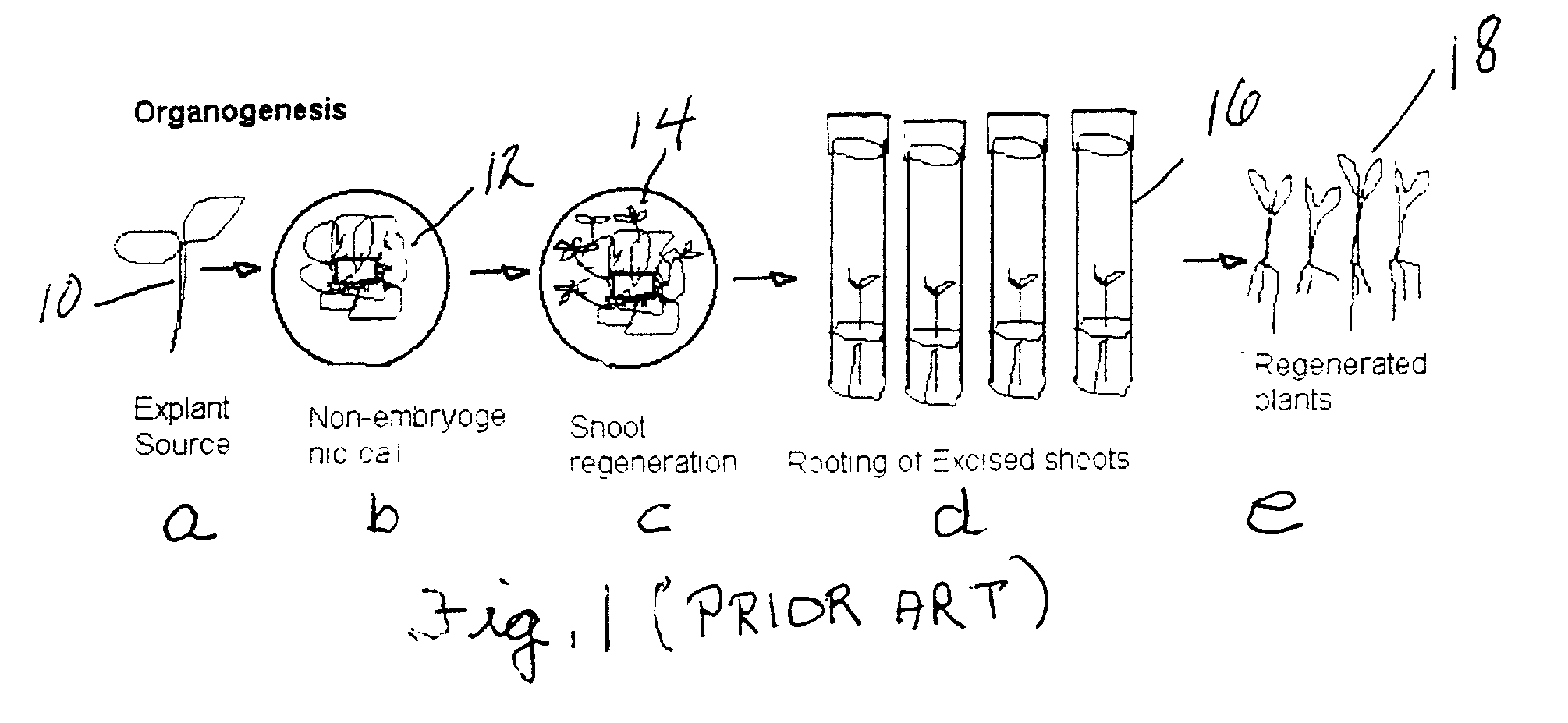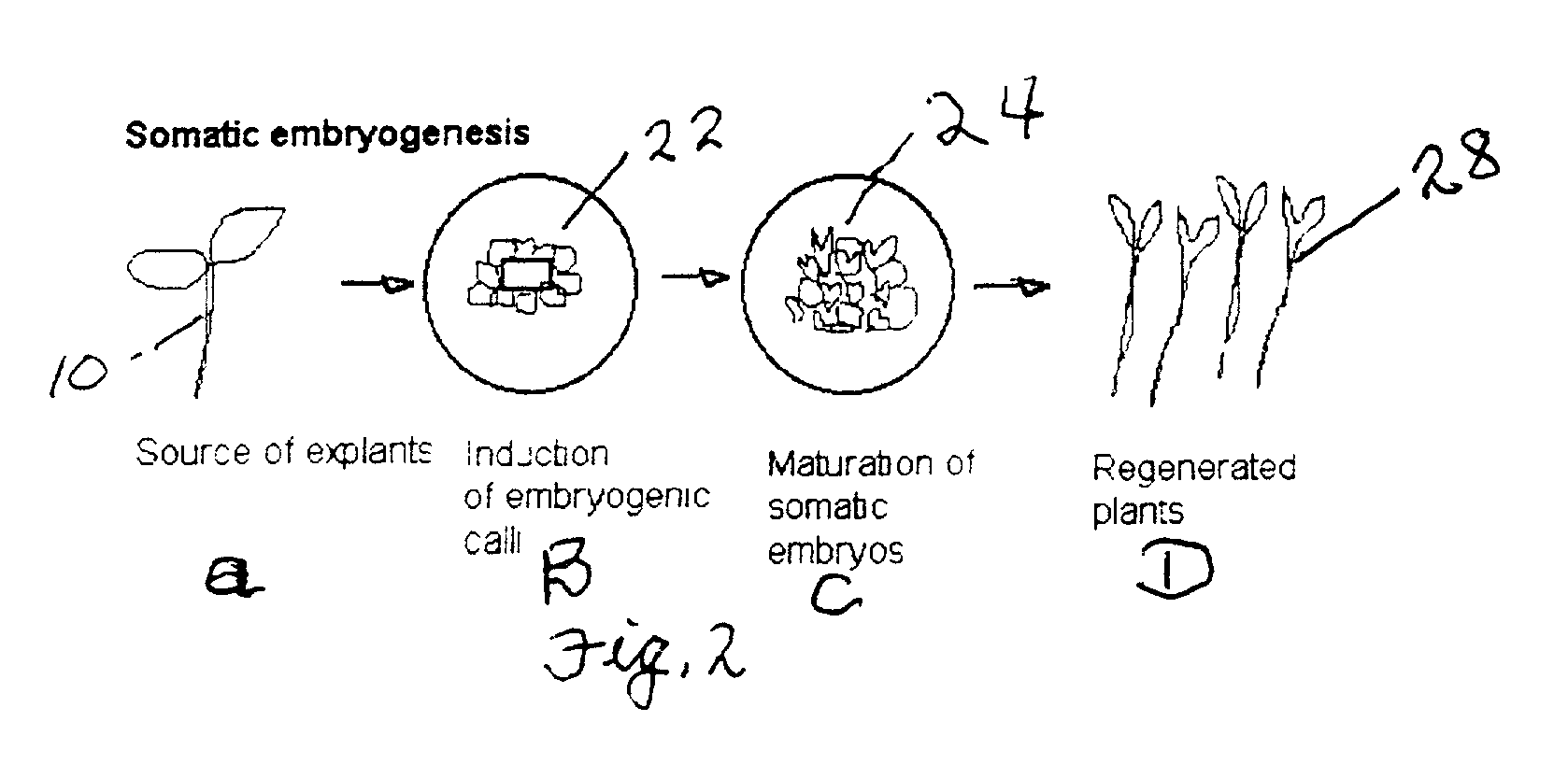Methods to propagate plants via somatic embryogenesis and to transfer genes into ornamental statice and other members of the family plumbaginaceae
- Summary
- Abstract
- Description
- Claims
- Application Information
AI Technical Summary
Problems solved by technology
Method used
Image
Examples
example 2
[0042] Induction of embryogenic cultures.
[0043] Cotyledon and hypocotyl explants were dissected from 5-day old seedlings. The hypocotyls were cut 1 mm below the cotyledonary node and 1 mm above the hypocotyl-root junction to provide 2 mm-long explants. The cotyledons were separated from the cotyledon-petiole junction and halved into 2 to 3 mm long pieces. The explants were cultured, 10 per 100.times.15 mm Petri plate, on MS medium containing MS mineral salts, B5 vitamins (Gamborg et al. 1968), sucrose (2, 3 or 4% wt. / v), 0.1 mg.l.sup.-1 kinetin and 1, 2 or 5 mg.l.sup.-1 2,4-D, pH 5.8. The plates were sealed with parafilm (American National Can, WI) and incubated at 25.degree. C. under 16 / 8 h (day / night) light regime (PPFD 46 .mu.mol.quanta.m.sup.-2.s.sup.-1, cool white fluorescent lamps). The explants were subcultured every two weeks on the same media.
[0044] Cotyledon explants from L. bellidifolium and L. sinuatum initiated callus within 7-10 days in culture on media containing 1 m...
example 6
[0056] Example 6 discloses the histology of our plant regeneration to show that it is by somatic embryogenesis
[0057] L. bellidifolium cotyledon explants cultured for two weeks, suspension cells cultured for eight weeks and individual somatic embryos were fixed in 4% (v / v) formaldehyde and 1% (v / v) gluteraldehyde in 100 mM sodium phosphate buffer, pH 7. The samples were post-fixed in 1% (v / v) osmium tetroxide and dehydrated in a series of ethanol solutions. Embedding was in Spurr's standard resin. Serial sections of 0.5 or 1 .mu.m thickness were stained with Toluidine Blue and observed under a bright field microscope (Olyrnpus BH2-RFCA). Some of the Toluidine Blue stained sections were destained by soaking the sections in ethanol for 12 h, remounted and stained with Calcofluor-White ST (0.1% wt. / v) and examined under fluorescence field (305 nm).
[0058] Histological observations of cultured L. bellidifolium cotyledon explants indicate that the proembryonal cell complexes arise from par...
example 7
[0059] Example 7 discloses genetic transformation of Limonium species using the Agrobacterium-mediated gene transfer method.
[0060] The gene of interest (GOI) is cloned into a plant expression vector and the expression vector is transferred into the plant tissue using Agrobacterium tumefaciens. In this Example, a Ti-plasmid vector which contains right and left border sequences, NPTII with NOS promoter to confer kanamycin resistance to the transformed tissue and green fluorescent protein (GFP) which is a visual marker to identify transformed plants was employed. The GFP is under the control of CaMV 35S promoter.
[0061] Cotyledons and hypocotyl segments are dissected from young in vitro germinated seedlings. The explants are immersed in Agrobacterium-containing somatic embryogenesis induction medium (O.D 600=0.3-0.8) for 10 min. with shaking at 100 rpm, blotted on sterile filter paper and cultured on agar solidified embryogenesis induction medium for 3 days (Cocultivation). The explants...
PUM
 Login to View More
Login to View More Abstract
Description
Claims
Application Information
 Login to View More
Login to View More - R&D
- Intellectual Property
- Life Sciences
- Materials
- Tech Scout
- Unparalleled Data Quality
- Higher Quality Content
- 60% Fewer Hallucinations
Browse by: Latest US Patents, China's latest patents, Technical Efficacy Thesaurus, Application Domain, Technology Topic, Popular Technical Reports.
© 2025 PatSnap. All rights reserved.Legal|Privacy policy|Modern Slavery Act Transparency Statement|Sitemap|About US| Contact US: help@patsnap.com


